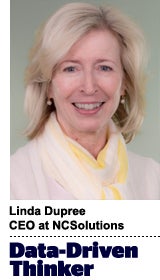“Data-Driven Thinking” is written by members of the media community and contains fresh ideas on the digital revolution in media.
Today’s column is written by Linda Dupree, CEO at NCSolutions.
When I started in this industry, advertising was like an unwanted houseguest. TV spots barged into our homes, stealing time from favorite shows. Ads slipped through the doors, tucked into the pages of magazines and the daily newspaper. Sometimes these intruders made us laugh. Some we found useful. But many we ignored or kicked to the curb.
It’s different today. The audience is always tuned in, yet they’re no longer reliant on anyone else’s schedule. Consumers are much more open to inviting advertisers in. Sometimes, they even make a place for us at the kitchen table. If a brand fits their lifestyle, meets their needs or satisfies their aspirations, consumers will open the door wide. But that doesn’t mean there aren’t caveats.
There are many people knocking on their doors, which increases the burden on marketers to cut through the noise. And the new rules of advertising put a premium on relationship building and authenticity. Before selecting a random door to knock on, we must perform due diligence and understand who our customers are, what they need and how we can motivate them to purchase. When we get this right, we improve our first impression and can better establish relationships. That’s when consumers swing their door open and let us stay for a while.
The perfect guest
Reach is great, but it’s no longer enough to knock on the doors of a million new consumers to offset churn. Now we’re obliged to ensure customers are satisfied and “sticky.” And that’s partly because the cost of acquiring new customers is going through the roof.
Building strong relationships requires being thoughtful about what we put in front of consumers. Even as data is an increasingly valuable input, media plays a much larger role. Creative remains the key driver of effective advertising, and quality is still the most important factor for influencing consumer behavior.
Unique creative can still be squandered, unless we tend the metrics of our expanding media universe. Timing and placement can’t be ignored or overlooked. And when creative and audience targeting are misaligned, the creative won’t resonate with the audience, or it may never even reach the audience most primed to respond. In either case, it’s not doing what is needed: to build trust, convey authenticity and strengthen the relationship with our intended audience.
Be a good listener
Advertisers need loyal customers – those so devoted that they jot down the brand name on the grocery list. As much as healthy, loyal relationships depend on the art of getting the creative right, they also rely on good listening. When we make a conscious effort to hear our consumers and adjust our behavior, we build rapport and consumers get what they want – a brand they trust that can deliver what they need.
We can more effectively listen and respond using science: setting up control and test groups, noting behavior differences and controlling for mitigating factors. Faster insights fueled by artificial intelligence and machine learning can accelerate decision making and place ads most effectively. Even if we need to adjust in the middle of a campaign, we can reach consumers where they are, in the right medium, with the right message.
We can further understand what consumers want by studying causality, or the complex dynamics that trigger decisions. What drives a new mom to buy Huggies? Is it her preferred brand? Did she see a Facebook ad before going grocery shopping?
The purchases from these ads – which appeared at this time, with this message, for this buyer, in this channel – aren’t the result of a decision to target an audience based on demographics or attribution. They’re the result of a decision based on intelligence about the entire situation. By designing creative based on a collection of causal factors on what drives consumer purchase decisions – who the buyers are, what their propensity to buy is, when they’re poised to purchase, what message resonates with them – we can better understand our consumers and influence their purchase decisions.
Don’t visit too often
Even after they let us in the door, consumers maintain high expectations for etiquette. For brands to stay, we need to follow the house rules.
For example, when brands overtarget or reuse valuable segments too often, we jeopardize the consumer relationship. It’s a classic example of overstaying your welcome. We need to know where to draw the line to avoid being the annoying houseguest that no one wants to return. Capping the creative’s frequency will help us keep the relationship golden.
Advertising has changed since I started in this industry. It’s faster, more complex, noisier – but boy, is it much more interesting. Brands have never had so many opportunities to understand who their consumers are and how to build meaningful, long-lasting relationships with them. And that is really exciting.
Follow NCS (@ncsolutions) and AdExchanger (@adexchanger) on Twitter.













